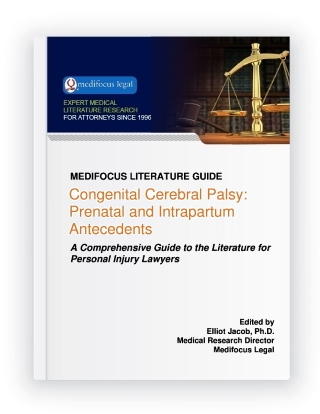Congenital Cerebral Palsy: Prenatal and Intrapartum AntecedentsA Comprehensive Guide to the Literature for Personal Injury Lawyers
Publisher: Medifocus Legal
Publication Date: March 11, 2020
Number of Pages: 151
A Comprehensive Guide to the Literature for Personal Injury Lawyers
Publisher: Medifocus LegalPublication Date: March 11, 2020
Number of Pages: 151
- Spasticity - stiff muscles
- Dyskinesias - uncontrollable movements
- Ataxia - problems with balance and coordination
According to the CDC's Autism and Developmental Disabilities Monitoring (ADDM) Networks, the prevalence estimates of CP range from 1.5 to more than 4 per 1,000 live births or children of a defined age. Data from ADDM also showed that CP affected males more than females and was more common in African-American than White children. In addition to CP, 41% of the subjects in the ADDM study also suffered from epilepsy and 7% were diagnosed with autistic spectrum disorder.
The overwhelming majority (85% to 90%) of CP cases result from brain damage that occurs either before or during birth. This condition is referred to as congenital CP. In a much smaller percentage of cases, CP develops as a consequence of brain damage that occurs a month or more after birth - a condition known as acquired CP.
Risk factors for Congenital CP include:
- Premature birth
- Low birth weight
- Multiple births in a single delivery
- Infertility treatments with assisted reproductive technology
- Infections during pregnancy - chickenpox, rubella, cytomegalovirus, maternal pelvic infections
- Jaundice and kernicterus
- Birth complications - uterine rupture, placenta detachment, umbilical cord entanglement
Medical malpractice litigation involving brain-damaged infants are among the most costly lawsuits, with the average indemnity for these types of cases exceeding $500,000. Typically, the most common claim is that a hypoxic-ischemic event (intrapartum asphyxia) led to long-term neurologic sequelae, including congenital CP and/or developmental delay. A key element that is likely to be at the center of dispute during litigation of CP cases is the timing of the infant's brain injury. The plaintiff will attempt to prove that the injury occurred during the intrapartum period, while the defense will invariably argue that the brain injury occurred prenatally.
The MediFocus Literature Guide to Congenital Cerebral Palsy: Perinatal and Intrapartum Antecedents is a comprehensive Guide to the medical literature for personal injury attorneys who may represent families of infants suffering with CP. This unique Literature Guide includes over 230 hand-selected references to articles published in peer-reviewed journals with links to the abstracts of the articles. The articles included in the Guide represent the current medical and scientific knowledge regarding congenital cerebral palsy and focus primarily on the perinatal and intrapartum risk factors that have been implicated in causation. The Guide also includes a valuable Author Directory for quickly identifying and locating medical experts with specialized knowledge about congenital CP.
 |
- A comprehensive bibliography of 238 journal article references indexed in MEDLINE published in well respected medical and scientific journals.
- Online access to the abstracts (summaries) of the articles.
- Online access to the free full-text version of 10 articles.
- Links to full-text sources of other articles that are available for purchase directly from individual journal publishers.
- A unique "Author Directory" consisting of the names and institutional affiliations of experts who have published and have specialized knowledge about Congenital Cerebral Palsy: Prenatal and Intrapartum Antecedents. The "Author Directory" is a valuable resource for quickly identifying and locating experts for case reviews, opinions, and testimony.
Select examples of topics that are covered by the articles referenced in this Guidebook include:
- Risk management and provider liabilities in infantile cerebral palsy based on malpractice litigation cases.
- Magnetic Resonance Imaging of Cerebral Palsy in the Assessment of Time of Brain Insult.
- Chorioamnionitis in the Development of Cerebral Palsy: A Meta-analysis and Systematic Review.
- Antenatal and intrapartum interventions for preventing cerebral palsy: an overview of Cochrane systematic reviews.
- Threshold of metabolic acidosis associated with newborn cerebral palsy: medical legal implications.
- Motor vehicle crashes during pregnancy and cerebral palsy during infancy: a longitudinal cohort analysis.
- Long-Term Cognitive Outcomes of Birth Asphyxia and the Contribution of Identified Perinatal Asphyxia to Cerebral Palsy.
- Cerebral palsy after neonatal encephalopathy: do neonates with suspected asphyxia have worse outcomes?
- Litigation related to intrapartum fetal surveillance.
- Neurological damage arising from intrapartum hypoxia/acidosis.
- Compensating cerebra palsy cases: Problems in court litigation and the no-fault alternative.
- Cerebral Palsy after Neonatal Encephalopathy: How Much Is Preventable?
- Medico-legal implications of hypoxic-ischemic birth injury.
- Risk of cerebral palsy in relation to pregnancy disorders and preterm birth: a national cohort study.
- Fault and blame, insults to the perinatal brain may be remote from time of birth.
- Cesarean delivery and cerebral palsy: a systematic review and meta-analysis.
- Maternal infections during pregnancy and cerebral palsy: a population-based cohort study.
- Clinical features of abruptio placentae as a prominent cause of cerebral palsy.
- Obstetric malpractice litigation and cerebral palsy in term infants.
- Asphyxia-related risk factors and their timing in spastic cerebral palsy.
is available in two formats: | |
Order by Phone:To order by phone, please call: Order by Mail:To order by mail, please print and complete this Order Form | |

